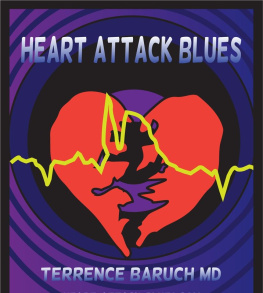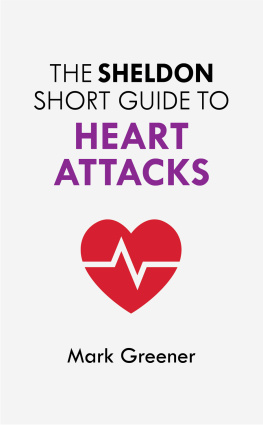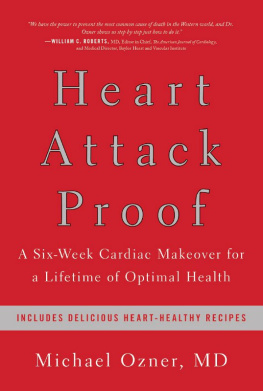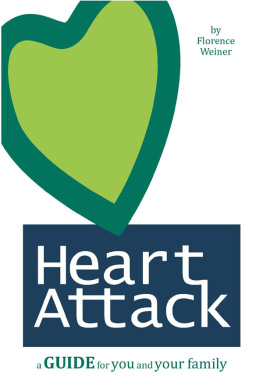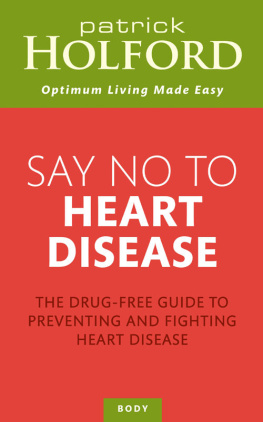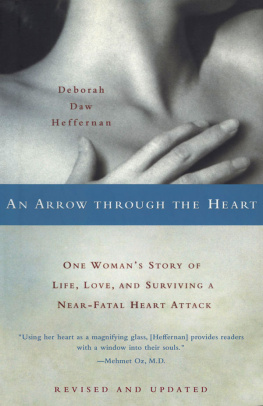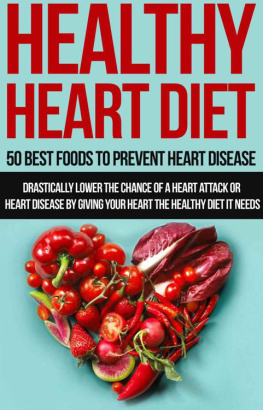Copyright 2013 by Luminosity Records
All rights reserved.
ISBN: 978-0-615-80311-1
Project editor: Sheila Buff
Cover design: Savva Teteriatnikov
The information in this book and the associated Web site http://heart-attack-blues.com is intended to help you make informed decisions about your health. It is not intended as a substitute for medical treatment. This information should be used in conjunction with the guidance and care of your physician. If you think you have a medical problem, seek competent professional help. If you think you are having a heart attack, call 911 at once.
To my wife with all my love, without you I could not be where I am.
Contents
About the Author
Terrence Baruch, MD, FACC has been practicing interventional cardiology since 1992 in the Pasadena-Arcadia area of Los Angeles County, California. He has performed more than 10,000 cardiac procedures in that time; well over 500 have been emergency angioplasties for treatment of acute myocardial infarction. He is the director of the Cardiac Catheterization Laboratory and the founder and director of the Heart Attack Program at the Methodist Hospital of Southern California.
Dr. Baruch played an active role in the development of one of the first regional heart attack programs in southern California. He helped develop a program that trained emergency medical services (EMS) personnel to recognize a suspected heart attack, stabilize the patient, and then transport him or her to a cardiac center of excellence.
Because of his expertise and vast experience, Dr. Baruch has been a national speaker on the state-of-the-art treatment of myocardial infarction, sponsored by companies such as Schering-Plough, Lilly, and Aventis. He has lectured at multiple hospitals in more than 20 different states, including Alaska and Hawaii. He has provided educational materials, guidelines, pathways, and sample hospital orders to these institutions so that they could organize their own STEMI programs.
Introduction
When I was a young cardiologist-in-training back in the mid-1980s, we were taught how to use clot-busting drugs to treat heart attacks. The drugs dissolved the clot in a coronary artery that was causing the heart attack. Although these drugs were a big step forward in treating heart attacks, they had some drawbacks. The biggest was that they worked well only about half the time. Then, when I was halfway through my training, my world was rocked by the introduction of angioplasty. By snaking a catheter into the clogged coronary artery of someone having a heart attack, we could open the artery and restore normal blood flow to the heart. I was fortunate to be able to learn this technique from many of the doctors who pioneered it. I was fortunate again to be able to develop the first heart attack program at Methodist Hospital of Southern California in Los Angeles. We were among the first in southern California to use catheterization as the preferred treatment for a heart attack.
Percutaneous coronary intervention (PCI), as this catheterization technique is called, works best when it is performed quickly. The gold standard is 90 minutes from arrival in the emergency room to the cath lab. At Methodist Hospital, we were soon able to achieve the goal of 90 minutes or less (sometimes much less) for almost every patient.
Even so, our outcomes werent always as good as possible. Why? Because when it comes to heart attacks, time is muscle. We could get a heart attack victims artery unclogged soon after he or she arrived at the hospital. What we couldnt do was fix the damage that happened before that. Too many patients were waiting too long to call 911. When they did, they were taken directly to the nearest hospitaleven if that hospital didnt have a cath laband then transferred on to us at Methodist. That meant further delay and further permanent damage to the heart muscle. While we could quickly unclog a blocked heart artery when the patient finally got to us, we couldnt repair the damage that had occurred before then.
I wasnt the only cardiologist who was frustrated by this problem. In the early 2000s, hospitals around the country began setting up receiving programs for heart attack patients. The idea was to designate a central hospital in the area as a cardiac care center of excellence. The hospital needed to have a fully equipped cath lab with a full-time staff on round-the-clock call. Patients with suspected heart attacks would be sent directly to this hospital, even if it was further away than the nearest emergency room. The idea wasnt that different from tiered trauma centers, a life-saving concept that was already in place.
In 2007, I worked closely with the Emergency Medical Services in Los Angeles County to create a county-wide heart attack network of STEMI receiving centers, or SRCs (STEMI is doctor-speak for a heart attack). The end result was an outstanding SRC network, one that has saved many lives since then. In 2008, we developed the pilot program for the Call 911 protocol. In 2009 the program became official policy and was accepted by all 33 of the STEMI receiving centers in Los Angeles County. I am still the chair of the Los Angeles County Emergency Medical Services SRC Advisory Committee.
Theres no doubt that SRCs save livesbut only if patients use them. Too often, we find that people with heart attack symptoms dont realize what is happening to them. They ignore or endure the symptoms, often for hours, and then finally take themselves to the nearest emergency room.
Ive treated many, many patients who waited too long to get treatment for their heart attack. When I talk with them about why they waited, they usually tell me that they didnt know their symptoms meant heart trouble. They thought they were having bad indigestion or a stomach bug, or that they had strained a chest or arm muscle, or that their gall bladder was acting up again, or that they were just overtired. Some were pretty sure they were having a heart attack but decided not to call 911. Instead, they waited until someone could drive them to the hospital.
I can unclog your heart in 20 minutesbut you have to get to me first! That means knowing your risk of having a heart attack, knowing what the symptoms are, and knowing to call 911 at once. In places that dont have SRC networks, it also means knowing which hospital in your area is a cardiac center of excellence and going directly to it.
My goal with this book and the accompanying video is to help you save your own life. I hope it will help you understand what a heart attack, how it should be treated, and most importantly, why time is muscle.
Prologue: Are You at Risk of a Heart Attack?
Death first became a reality to me on Friday, November 22, 1963.
I took the day off from the fifth grade, claiming not to be feeling well. My real intention was getting started on a three-day weekend.
At 10:30 a.m. PST, I was just about to watch a rerun of the situation comedy, Pete and Gladys. When youre 10 years old, just about anything is funny.
Suddenly, a news flash broke and interrupted the show. A teary-eyed Walter Cronkite announced that John F. Kennedy, the thirty-fifth president of the United States, had been shot in Dallas, Texas. He had been rushed to the nearest hospital for treatment.
I stuck like glue to the TV. Both my parents were working, so I had no one to tell what was happening. After about an hour, the announcement was made that JFK was dead.
All of us who are old enough remember the precise details of where we were at that moment.
Although the president was a distant figure to a 10-year-old, his death still felt very personal to me. Prior to this, I had never known anyone who had died. My only experience with death was when people died on TV, but I knew that wasnt real. The next week they would be alive again on some different show.
Next page
